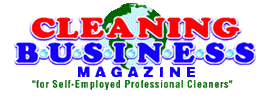Training: Overlooked And Undervalued
If there is any one area of management that is often overlooked and undervalued, it has to be employee training.
As a supervisor, manager or owner, you don’t have many options other than training to get employees to do the job correctly or to improve the quality and production of tasks that are assigned.
The easy way out would be to say that training doesn’t cost, it pays.
In reality, training does have costs; it takes time, and there are materials to be produced and/or purchased.
When an employee is participating in training, the clock is running and the work isn’t getting done.
However, the cost of failing to properly train employees at all levels of an organization is far greater than the cost of an effective training program.
Tracking the return on your investment in training can be difficult.
From a practical standpoint, most companies don’t do it.
Most cleaning companies aren’t that sophisticated and don’t see the need to closely track the cost or the return on investment for employee training.
Management sees training as an overhead cost, and any lost labor production due to training is absorbed during the balance of the shift with no extra labor or cost.
To track the actual cost and return on investment associated with training, you need to be organized and sophisticated in your accounting processes.
You will need to know and be able to track costs associated with areas of your operation that would be impacted by training.
This includes such things as: Employee turnover rate for cleaners, supervisors and managers; employee screening and hiring costs; accidents and related costs of lost time, claims and worker compensation; account turnover; training materials; etc.
With this information, you will be able to track training costs and return on investment.
Training shouldn’t be complicated or overly time-consuming.
Every interaction with an employee can be an informal and brief training session if you approach it correctly.
The most effective training takes place on the job when a co-worker or supervisor explains and shows an employee how to properly perform a task and then coaches that person to properly execute the task.
The most effective approach to employee training utilizes a combination of resources that includes written, visual and hands-on involvement of both the instructor and the student.
Sharpen Your Skills
As a trainer, supervisor or manager, you lead the way and must stay current not only with industry trends, but also with new and more effective instructional techniques and materials.
There are many resources available today to assist you in preparing for and conducting all types and levels of training.
Don’t approach training alone; suppliers, consultants, associations, manufactures, co-workers and others have materials, technical support and skilled staff available to assist you.
Employees who are involved in a training program that prepares them for upward mobility with the potential to increase their income and status with the right coaching and encouragement set personal goals that are inline with company goals.
This level of personal commitment encourages employees to work hard and do a better job for the customer, the company and themselves.
This change in attitude results in less customer and staff turnover and brings about more rapid growth and profit for the employer.
Every employer needs to create an upward mobility ladder within its organization that will encourage employees to improve their skills.
Information about a company’s “upward mobility program” should be provided to each employee during the initial hiring process.
To attract and retain qualified employees, we must learn to sell and deliver opportunity not just a cleaning job.
Supervisors and managers must then continue to promote the program to employees and use it as a marketing tool with potential customers and suppliers.
The world we live in is far more complicated than it was a few short years ago.
For success, regardless of how you define it, a business must do everything possible to develop and retain a motivated and professional workforce that enables the organization to control costs and effectively compete in a rapidly changing marketplace.
Training is the best tool available to help supervisors, managers and business owners accomplish these goals.
















